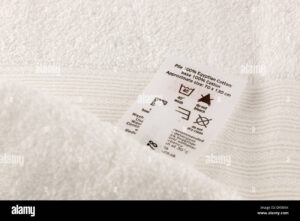How to Dry Bath Towels? Learn the Best Techniques & Tips
To dry bath towels effectively and efficiently, firstly, shake out the towels to loosen the fibers, then place them in a dryer on medium heat.
If weather permits, you can also hang them outdoors. Always ensure they are dry before folding and storing them to prevent mildew.
Wet bath towels present a damp and warm environment that promotes the growth of bacteria, mold, and mildew. Therefore, it’s important to dry them properly. Towels should be completely dried before being folded and stored away.
Proper care for your bath towels not only enhances their longevity but also maintains their absorbency and softness. Drying your bath towels properly is essential in this process.
This includes shaking them out after use to loosen the fibers, machine-drying them on medium heat, and always ensuring they are completely dry before storage to prevent the growth of bacteria, mold, and mildew.

Key Takeaway
The Importance Of Properly Drying Bath Towels
Properly drying bath towels is essential to maintaining their cleanliness and freshness. Follow these simple steps to ensure your bath towels are thoroughly dried, preventing mold and mildew growth while prolonging their lifespan.
Why Drying Bath Towels Correctly Matters?
Bath towels are an essential part of our daily lives, providing us with comfort and warmth after a relaxing bath or invigorating shower. However, many of us overlook the importance of properly drying our towels.
By following the right drying techniques, we can ensure that our towels remain in excellent condition and provide us with long-lasting softness and absorbency.
We will explore the impact of improper drying on towel quality and longevity to emphasize why it matters. Let’s dive in.
The Impact Of Improper Drying On Towel Quality And Longevity
The improper drying of bath towels can have detrimental effects on their overall quality and lifespan.
Here are a few key points to consider:
- Loss of absorbency: When towels are not dried correctly, they may retain excess moisture, leading to reduced absorbency. This means they won’t effectively dry you off, leaving you feeling damp and uncomfortable.
- Unpleasant odors: Insufficient airflow during the drying process can create a breeding ground for bacteria and mildew, resulting in unpleasant odors that linger on the towels. This not only affects their freshness but can also transfer onto your body when you use them again.
- Faster wear and tear: Improper drying methods can cause towels to become rough, stiff, or even develop snags and frayed edges. The fabric may lose its softness and luxurious feel, leading to a decrease in overall durability and an earlier need for replacement.
- Reduced lifespan: Towels that are continuously subjected to improper drying techniques are more prone to damage and wear, significantly shortening their lifespan. By adopting proper drying methods, you can extend the life of your towels and save money in the long run.
- Mold and mildew growth: When towels remain damp for extended periods, they are susceptible to mold and mildew growth. Not only can this compromise the integrity of the towel, but it also poses potential health risks to users.
- Discoloration and deterioration: Incorrect drying techniques, such as prolonged exposure to direct sunlight, can cause towels to fade, lose their vibrant colors, and weaken the fabric fibers. This can result in a tired and worn appearance.
Proper drying techniques are essential for maintaining the quality, longevity, and functionality of bath towels.
By understanding the negative impact of improper drying and implementing the right methods, you can ensure that your towels remain soft, absorbent, and luxurious for an extended period.
So, let’s explore the best practices for drying bath towels in our next section.
Understanding Towel Fabrics And Their Drying Needs
Learn how to effectively dry your bath towels by understanding the different fabric types and their specific drying needs. Avoid common mistakes and ensure maximum absorbency and longevity.
Towels are an essential part of our daily lives, allowing us to dry off after a refreshing shower or swim. However, not all towels are created equal, and understanding the different fabric types and their drying needs is crucial to keep your towels in top condition.
Whether you prefer plush and fluffy towels or lightweight and quick-drying ones, knowing which fabric suits your needs will help you maintain their quality and extend their lifespan.
Different Towel Materials And Their Characteristics
There are various types of towel fabrics available, with each offering unique characteristics that determine their drying capabilities.
Here are the most common towel materials and their key features:
Cotton:
- Highly absorbent: Cotton towels have excellent moisture-wicking properties, making them ideal for efficiently drying your body.
- Soft and gentle: Cotton fibers are known for their natural softness, ensuring a cozy feel against your skin.
- Durable and long-lasting: Cotton towels are resilient and can withstand frequent washing without losing their shape or softness.
Microfiber:
- Super absorbent: Microfiber towels can absorb several times their weight in water, making them perfect for quick and effective drying.
- Quick-drying: Due to their ultra-fine fibers, microfiber towels dry rapidly, preventing the growth of odors and bacteria.
- Compact and lightweight: Microfiber towels are lightweight and take up minimal space, making them great for travel or outdoor activities.
Bamboo:
- Eco-friendly: Bamboo towels are made from bamboo fibers, a sustainable and renewable resource.
- Antimicrobial properties: Bamboo fabrics naturally inhibit the growth of bacteria, keeping your towels fresh and odor-free.
- Silky smooth: Bamboo towels have a luxuriously soft texture, providing a luxurious and gentle drying experience.
Linen:
- Fast-drying: Linen towels have exceptional moisture-wicking properties, allowing them to dry quickly between uses.
- Lightweight and breathable: Linen fabric is lightweight and breathable, making it an excellent choice for hot and humid climates.
- Naturally exfoliating: The slightly coarse texture of linen towels offers a gentle exfoliating effect, leaving your skin feeling refreshed.
Synthetic blends:
- Enhanced durability: Towels made from synthetic blends, such as cotton-polyester or cotton-rayon, boast increased durability and resistance to wear and tear.
- Wrinkle-resistant: Synthetic blend towels tend to be less prone to wrinkling, helping them maintain a neat appearance even after multiple uses.
- Wide range of styles: These blends often come in various designs and patterns, allowing for personalization and aesthetic appeal.
Understanding the different fabric types and their characteristics is crucial for effective towel drying. By choosing the right material, you can ensure optimal absorption, quick drying, and long-lasting durability for your towels.
Air Drying Vs. Machine Drying
Air drying and machine drying are two common methods to dry bath towels. Air drying is eco-friendly and gentle on fabrics, while machine drying is quick and convenient. Consider the benefits of each method to find the best option for your needs.
Do you ever wonder whether it’s better to air dry or machine dry your bath towels? You’re not alone. Choosing the right drying method can have an impact on both the longevity and quality of your towels.
We’ll explore the pros and cons of air drying and machine drying towels, helping you make an informed decision.
Pros And Cons Of Air Drying Towels
Air drying towels may seem like the traditional approach, but it comes with its own set of advantages and disadvantages.
Let’s take a closer look:
- Gentle on fabrics: Air drying towels is a gentle method that helps preserve the fabric’s color, texture, and softness. Towels tend to maintain their original quality for a longer time.
- Energy-saving: By opting for air drying, you can reduce your energy consumption and consequently, your utility bills. It’s an eco-friendly alternative that doesn’t require any electricity.
- Time-consuming: Air drying towels can take quite some time, especially if you don’t have a lot of space or access to sunlight. It may require patience, as towels can take hours or even days to completely dry.
- Prone to stiffness: Air drying can sometimes result in towels feeling stiff or crunchy. This can be remedied by giving the towel a quick shake or by fluffing it in the dryer for a few minutes after air drying.
Pros And Cons Of Machine Drying Towels
Machine drying, on the other hand, offers its own set of benefits and drawbacks.
Let’s explore them below:
- Quick and efficient: Machine drying towels is undoubtedly a time-saving option. With the right settings, your towels can be ready for use in a matter of minutes, so you won’t have to wait around for them to dry naturally.
- Softer feel: Towels that have been machine dried often have a softer feel compared to air-dried towels. The heat from the dryer can help fluff up the fabric and make it more plush.
- Potential fabric damage: High heat levels can take a toll on the fabric over time, causing it to lose its softness and become worn out more quickly. It’s crucial to choose the appropriate dryer settings to avoid damaging your towels.
- Energy consumption: Machine drying requires electricity, which can contribute to your overall energy consumption. If you’re looking to reduce your environmental impact or save on utility costs, air drying might be a better option.
Now that you’re aware of the pros and cons of air drying and machine drying, you can decide which method suits you best. Consider your priorities, convenience, and the specific needs of your towels to make the right choice.
How To Air Dry Bath Towels?
Air drying bath towels is a simple and efficient way to preserve their quality and extend their lifespan. Hang them on a towel rack or clothesline, ensuring proper airflow and avoiding direct sunlight, for the best results.
Choosing The Right Location For Air Drying Towels:
- Find a well-ventilated area: Look for a location with good air circulation to help towels dry more quickly and avoid the buildup of musty odors.
- Choose a sunny spot: Sunlight is a natural disinfectant and can help kill bacteria on your towels. Find a sunny area where you can hang your towels to dry.
- Avoid humid spaces: Steer clear of areas with high humidity, such as bathrooms or damp basements. Excess moisture can prolong the drying process and increase the risk of mildew.
- Consider outdoor options: If weather permits, hanging your towels outside can be an excellent choice. The fresh air and sunlight will aid in faster drying and give your towels a pleasant scent.
Tips For Hanging Towels To Dry Efficiently:
- Use a sturdy clothesline or drying rack: Ensure that your chosen method can support the weight of wet towels without sagging or breaking.
- Avoid folding towels over the line: To allow for maximum airflow, hang towels in single layers. This helps them dry more efficiently.
- Spread out the towel: Avoid bunching or folding towels as this can create moisture pockets and prolong drying time. Instead, spread them out evenly to expose as much surface area as possible.
- Shake towels before hanging: Gently shake your towels before hanging them to remove any excess moisture and help them dry faster. This simple action can make a significant difference in drying time.
Best Practices For Preventing Odors And Mildew During Air Drying:
- Wash towels before air drying: Ensure your towels are clean before hanging them to dry. Lingering dirt or bacteria can lead to unpleasant odors.
- Avoid overloading the drying space: Give your towels plenty of space to breathe as they dry. Overcrowding can limit airflow and increase the risk of lingering moisture and mustiness.
- Rotate towel positions: To promote even drying, periodically rearrange the position of your towels so that all sides are exposed to fresh air.
- Consider using a fan: If you have access to a fan, direct it towards your towels to enhance air circulation and expedite the drying process.
- Maintain cleanliness: Regularly clean the drying area to prevent any buildup of dust or dirt that could transfer to your freshly washed towels.
Remember, choosing the right location, hanging towels properly, and implementing best practices will help you achieve fresh, dry towels every time you air dry them.
How To Machine Dry Bath Towels?
Learn the best technique for machine drying bath towels effectively. Follow these simple steps to ensure your towels come out fluffy and dry, ready for immediate use.
Setting The Right Temperature And Cycle For Towel Drying
Using the appropriate temperature and cycle settings when machine drying bath towels is crucial to ensure optimal results.
Here’s what you need to know:
- Set the temperature: Select a medium heat setting for machine drying bath towels. High heat may cause excessive shrinkage, while low heat may result in towels that are still damp.
- Choose the right cycle: Opt for a regular or normal cycle to dry your towels effectively. Avoid using delicate or gentle cycles, as they may not provide enough agitation to thoroughly dry the towels.
- Time it right: Keep in mind that the drying time for towels can vary depending on factors such as towel thickness, machine efficiency, and load size. Regularly check the towels during the cycle to prevent over-drying.
Using Fabric Softeners And Anti-Static Agents
Incorporating fabric softeners and anti-static agents during machine drying can enhance the softness and eliminate static cling in your bath towels.
Here’s how to do it:
- Fabric softeners: Add a suitable fabric softener to the designated dispenser or the fabric softener compartment of your washing machine. This will infuse the towels with a pleasant scent and leave them feeling luxuriously soft.
- Dryer sheets: Place a dryer sheet in the dryer with your towels. The dryer sheet will reduce static electricity and add a fresh fragrance to your freshly dried towels.
Preventing Shrinkage And Damage During Machine Drying
To prevent shrinkage and minimize the risk of damage when machine drying bath towels, follow these guidelines:
- Avoid overloading: It’s important not to overload the dryer with too many towels. Overcrowding the dryer can hinder proper airflow and result in uneven drying or even damage. Instead, dry towels in small to medium-sized loads.
- Remove promptly: Once the drying cycle is complete, promptly remove the towels from the dryer to avoid excessive wrinkling. Smooth out any wrinkles by hand or by hanging the towel for a short while.
- Don’t overdo it: Over-drying towels can lead to stiff and rough fabric. Avoid leaving towels in the dryer for an extended period and opt for slightly damp towels that you can finish air drying if needed.
- Avoid high heat: High heat settings can cause shrinkage and damage delicate fibers. Stick to medium heat, as mentioned earlier, for a gentle drying process that maintains the towel’s quality.
Remembering these tips will help you achieve perfectly dried bath towels that are soft, fluffy, and ready to provide exceptional comfort and functionality. Machine drying is a convenient method that ensures your towels are always fresh and ready for use.
Tips For Quick And Effective Drying
Looking for tips on how to quickly and effectively dry your bath towels? Check out these six guidelines for a seamless and efficient drying process. Say goodbye to damp towels with these helpful tips.
When it comes to drying your bath towels, there are a few handy tips you can follow to ensure they dry quickly and effectively.
From towel-specific drying techniques to maximizing airflow during the drying process and utilizing towel drying accessories, these tips will help you keep your towels in top-notch condition.
Let’s dive in:
Using Towel-Specific Drying Techniques:
- Shake it out: Before you hang your towel to dry, give it a good shake to remove any excess moisture. This will help speed up the drying process.
- Hang it up: Invest in a sturdy towel rack or hooks for proper towel drying. Make sure to spread the towel out fully to maximize the surface area exposed to air.
- Flip it halfway: If your towel is quite thick or plush, flip it over halfway through the drying process to ensure that both sides dry evenly.
- Avoid direct sunlight: While it may be tempting to dry your towels under the sun, direct sunlight can actually fade the colors and weaken the fibers. Opt for a shaded area or indoors instead.
Maximizing Airflow During The Drying Process:
- Spread them out: Avoid overcrowding your towels on the drying rack or line. Leave some space between each towel to allow air to circulate and aid in drying.
- Use a fan: If you have a ceiling or portable fan, position it near the towels to facilitate airflow. The extra breeze can significantly speed up the drying time.
- Lifting technique: Give your towels a little lift or shake every now and then while they’re drying. This movement helps to let fresh air reach different parts of the towel and aids in faster drying.
Utilizing Towel Drying Accessories:
- Towel clips: Consider using towel clips to secure your towels onto the drying line or rack. This prevents them from slipping off when faced with a gust of wind, ensuring they dry efficiently.
- Towel warmer: If you’re willing to invest in a towel warmer, it can be a game-changer. These handy devices provide gentle heat that dries your towels quickly and keeps them warm for a cozy post-bath experience.
By implementing these towel-drying tips, you can say goodbye to damp towels and hello to warm, dry, and fluffy ones in no time. Make sure to take care of your towels and enjoy the comfort and freshness they bring to your daily routine.
Storing Dried Towels Properly
Properly storing dried towels is essential for maintaining their quality and hygiene. Learn effective tips and techniques for drying bath towels to ensure they stay fresh and fluffy after every use.
When it comes to keeping your towels in top condition, proper storage is key. You don’t want to undo all your hard work of drying them correctly, only to have them end up musty and unpleasant.
Follow these best practices for folding and storing bath towels, as well as ways to prevent musty odors and maintain freshness.
Best Practices For Folding And Storing Bath Towels:
- Fold towels neatly: Take the time to fold your bath towels properly. Neatly folded towels not only look better but also take up less space in your linen closet.
- Stack towels vertically: Instead of horizontally piling towels on top of each other, stack them vertically. This allows for better airflow and helps prevent musty odors.
- Use dividers or baskets: Consider using dividers or baskets to separate different sets of towels or types of towels. This makes it easier to find the towel you need without disturbing the rest.
- Optimize storage space: If you’re short on storage space, try rolling your towels instead of folding them. This method not only saves space but also creates a visually appealing display.
Ways To Prevent Musty Odors And Maintain Freshness:
- Ensure towels are completely dry: Before storing your towels, make sure they are completely dry. Any lingering moisture can lead to musty odors and the growth of mold and mildew.
- Store towels in a well-ventilated area: Choose a storage location that is well-ventilated. Good airflow helps prevent moisture buildup and keeps your towels smelling fresh.
- Avoid storing towels in plastic bags: While it may seem convenient to store towels in plastic bags, this can trap moisture. Instead, opt for breathable fabric bags or baskets.
- Use natural odor absorbers: To keep towels smelling fresh, try placing natural odor absorbers, such as cedar chips or sachets of baking soda, in your linen closet or storage area.
By following these best practices for folding and storing bath towels and implementing ways to prevent musty odors and maintain freshness, you can extend the lifespan of your towels and enjoy their softness and absorbency for longer periods.
Ensuring Longevity Of Bath Towels
Properly drying bath towels is crucial for their longevity. Hang them in a well-ventilated area, avoiding direct sunlight, to prevent musty odors and prolong their lifespan.
Bath towels are essential for our daily lives, providing comfort and absorbency after a refreshing shower or relaxing bath.
To keep your towels in tip-top shape for longer, it’s important to follow some simple cleaning and maintenance tips.
Additionally, by adopting practices that extend the life of your bath towels, you can enjoy their softness and functionality for an extended period.
Let’s explore these strategies further:
Regular Cleaning And Maintenance Tips:
- Wash separately: Always wash your bath towels separately from other laundry items to prevent lint transfer and potential damage.
- Avoid fabric softeners: Contrary to popular belief, fabric softeners can actually reduce the absorbency of towels over time. Opt for white vinegar as a natural alternative to maintain their softness and functionality.
- Use gentle wash cycles: When laundering your bath towels, choose a gentle or delicate cycle to minimize wear and tear. This ensures your towels remain intact and in excellent condition.
- Avoid excessive detergent: Using excessive amounts of detergent can leave behind residue, making towels less absorbent over time. Follow the manufacturer’s guidelines and use an appropriate amount of detergent.
- Dry properly: Towels need to be dried thoroughly to prevent musty odors and the growth of bacteria. Air drying is the gentlest option, but if using a dryer, set it to a low or medium heat setting.
How To Extend The Life Of Bath Towels:
- Rotate towel usage: Rotating the use of your bath towels helps distribute wear and tear evenly across all of them. This prevents one towel from being excessively worn out while others remain relatively new.
- Hang properly: After each use, hang your towel in a well-ventilated area to allow it to dry completely. This reduces the likelihood of stale odors and bacteria growth.
- Avoid contact with skincare products: Try to minimize contact between your towels and any skincare products, such as lotions or oils. These products can cause staining and reduce the towel’s absorbency.
- Trim loose threads: Regularly inspect your towels and trim any loose threads to prevent them from unraveling. This simple practice can significantly extend their lifespan.
By adopting these regular cleaning and maintenance tips, as well as incorporating practices to extend the life of your bath towels, you can enjoy their softness, absorbency, and longevity for an extended period.
Remember, taking proper care of your towels not only ensures their durability but also contributes to a more pleasant post-bath experience.
Conclusion
Drying bath towels properly is crucial for maintaining their quality and longevity. By following these simple tips, you can ensure that your towels stay fluffy, absorbent, and free from unpleasant odors.
Start by properly wringing out excess water from the towels before hanging them on a clothesline or drying rack.
If you prefer using a dryer, opt for a low heat setting to prevent damage to the fabric. Regularly sanitize your towels by washing them with a laundry disinfectant or vinegar, which helps control bacteria growth.
Avoid using fabric softeners as they can reduce towel absorbency. Finally, ensure that your towels are fully dry before storing them to prevent the development of mold or mildew.
By implementing these practices, you can keep your bath towels fresh, cozy, and ready for your next luxurious bath or shower experience.






